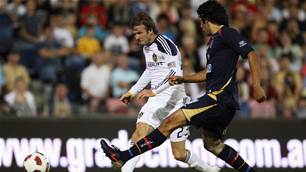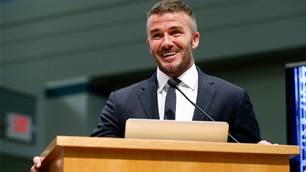He’s back in the England team and is a Spanish championship winner. Next on the David Beckham Revival Tour: Saving American “soccer”. Is Becks the man to help football break the dominance of the Big Four in the US?
Page 2 of 2 | Single page
Some of the Beckham coverage has referenced the 1964 arrival in the US of The Beatles. Others, perhaps more accurately, have asked if Beckham can have the same impact Pelé had when he came to play for the New York Cosmos in the 1970s, when the Brazilian outshone every American sports star and, for a while, helped US soccer fill 70,000-seater stadiums.
If football in the US is ever going to scale these heights again – and stay there – it’s going to have to have to reach black kids, particularly in the inner cities. The challenge is not so great in LA, where only 12 percent of the population is black and nearly 50 percent are of Hispanic and Latino, soccer-mad origin. In DC, however, the black population is approaching 60 percent, while in another six “MLS cities” that figure is between 24 and 36 percent. The majority of them have been relatively untouched by the soccer revolution. “Competitive youth soccer in the United States is the middle-class equivalent of dressage or polo,” explains Paul Kooistra, Sociology Professor at Furman University in Greenville, South Carolina and author of Bend it Like Bourdieu: Race, Class and Gender in American Youth Soccer. “It provides a way that middle class parents can separate themselves and their children from lower social classes and minorities,” he says.
But is Beckham the man to mobilise an African-American fan base? The fact that he chose Michael Jordan’s shirt number when he moved to Real Madrid suggests he might think so. And why has he taken to name-dropping iconic black music stars like P.Diddy, Usher and Snoop Dogg?
Either way, opinion is divided on whether Beckham can actually manage to sell soccer to the inner cities.
“At the moment black kids look at soccer the way they looked at golf before Tiger Woods,” says award-winning US journalist, Kia Gregory. “But there’s no reason Beckham couldn’t cross over if he’s got the skills – look at Eminem.”
Professor of Sociology Katharine Jones is less optimistic: “I think the race and class dynamics of soccer in the US are too complicated for Beckham to understand or bridge.”
Equally as important, can metrosexual, sarong-wearing gay icon David Beckham sell soccer to the ignorant rump of ass-scratching American males who think
soccer is a sissy sport played by “flopping-on-the-ground, writhing-in-pain homos”? “I don’t think so,” says Jennifer Robertson. “The beer-swilling, nacho-eating couch potato is already catered for with traditional US team sports.”
Beckham’s not walking into a vacuum. The US of 1975, when Pelé arrived, was barely a decade removed from almost total soccer ignorance, whereas football in the United States is now deeply rooted and undergoing real change – with or without its new English superstar.
Beyond the hype and excitement, there’s an ocean of cynicism surrounding Goldenballs’ move to the US. But the unvarnished truth is he’s still a potentially match-winning, international-class player. And a shrewd businessman who wouldn’t come within a thousand miles of US soccer if he thought it needed “saving”. But he does want the game to take off here.
At the end of the Los Angeles derby, Galaxy win 3-1, but you’d never know that from the crowd. The phalanx of Chivas Legionnaires – dressed in wigs, silly hats, and goat-faced wrestling masks and sunglasses – are pogoing like maniacs, making the stadium ring with a rapidly chanted “Chivas! Chivas! Chivas!”
And there’s something wonderful about seeing this red and white carnival flanked on both sides by yellow-clad, finger-jabbing Galaxy fans – including an alarming number of Galaxy headscarf-wearing teenage girls – all bellowing “Hey, Chivas? YOU SUCK!” These pony-tailed young characters are the
BenditlikeBeckhamistas (and their big and little sisters), and while they might be content to spend most of the game waving their free inflatable yellow wibbly-wobbly tubes and screaming every time slightly balding heart-throb Landon Donovan touches the ball, when push comes to shove, they ain’t afraid of no Goats.
After the NASL and subsequent youth soccer boom, the Chivas Legion Kalifas, the Galaxians and the Riot Squad – not to mention the Screaming Eagles, La Barra Brava, Empire Supporters Club, Raging Bull Nation, the Sons of Ben and Section 8 Chicago – are leading US soccer’s third revolution, supplemented by the national team, Uncle Sam’s Army.
Sure, the MLS soccer is way more fun to watch than the tediously chopped up, dumbed down, TV advert-wrecked disaster zones that constitute the rest of US sports – where the play is constantly interrupted by dancing girls, frisbee-catching dogs, mascot sumo-wrestling and PA exhortations to “make some noise”.
But the truth is that even if the MLS imported all the Galacticos plus Wayne Rooney and both Ronaldos, the live soccer on offer would probably still be inferior to that which can be watched every week on US television. But if Becks and co do get arses on seats, and if those arses are lucky enough to sit next to, say, the Chivas Legion, they’re going to experience something that is all but unique in American sports – the soccer carnival.
Earlier this year the MLS sent out a memo telling clubs to turn off the piped music, cut down on the PA chatter, stop the insulting “make some noise” bollocks and let the fans generate the atmosphere (Lord knows, the Premiership could take heed). At the Galaxy-Chivas game (despite intensely annoying quiz questions and KFC ads) the announcer pretty much shut the fuck up and let the fans make the noise. And – surprise, surprise – they did. All of them. It’s enough to put a smile on the face of even the most jaundiced, Yank-mocking Euro-snob.
So, you see, the bandwagon is already rolling. What the Galaxy and the MLS will be hoping, however, is that with Beckham’s five-star fuel in the tank, they just might get there faster.
If football in the US is ever going to scale these heights again – and stay there – it’s going to have to have to reach black kids, particularly in the inner cities. The challenge is not so great in LA, where only 12 percent of the population is black and nearly 50 percent are of Hispanic and Latino, soccer-mad origin. In DC, however, the black population is approaching 60 percent, while in another six “MLS cities” that figure is between 24 and 36 percent. The majority of them have been relatively untouched by the soccer revolution. “Competitive youth soccer in the United States is the middle-class equivalent of dressage or polo,” explains Paul Kooistra, Sociology Professor at Furman University in Greenville, South Carolina and author of Bend it Like Bourdieu: Race, Class and Gender in American Youth Soccer. “It provides a way that middle class parents can separate themselves and their children from lower social classes and minorities,” he says.
But is Beckham the man to mobilise an African-American fan base? The fact that he chose Michael Jordan’s shirt number when he moved to Real Madrid suggests he might think so. And why has he taken to name-dropping iconic black music stars like P.Diddy, Usher and Snoop Dogg?
Either way, opinion is divided on whether Beckham can actually manage to sell soccer to the inner cities.
“At the moment black kids look at soccer the way they looked at golf before Tiger Woods,” says award-winning US journalist, Kia Gregory. “But there’s no reason Beckham couldn’t cross over if he’s got the skills – look at Eminem.”
Professor of Sociology Katharine Jones is less optimistic: “I think the race and class dynamics of soccer in the US are too complicated for Beckham to understand or bridge.”
Equally as important, can metrosexual, sarong-wearing gay icon David Beckham sell soccer to the ignorant rump of ass-scratching American males who think
soccer is a sissy sport played by “flopping-on-the-ground, writhing-in-pain homos”? “I don’t think so,” says Jennifer Robertson. “The beer-swilling, nacho-eating couch potato is already catered for with traditional US team sports.”
Beckham’s not walking into a vacuum. The US of 1975, when Pelé arrived, was barely a decade removed from almost total soccer ignorance, whereas football in the United States is now deeply rooted and undergoing real change – with or without its new English superstar.
Beyond the hype and excitement, there’s an ocean of cynicism surrounding Goldenballs’ move to the US. But the unvarnished truth is he’s still a potentially match-winning, international-class player. And a shrewd businessman who wouldn’t come within a thousand miles of US soccer if he thought it needed “saving”. But he does want the game to take off here.
At the end of the Los Angeles derby, Galaxy win 3-1, but you’d never know that from the crowd. The phalanx of Chivas Legionnaires – dressed in wigs, silly hats, and goat-faced wrestling masks and sunglasses – are pogoing like maniacs, making the stadium ring with a rapidly chanted “Chivas! Chivas! Chivas!”
And there’s something wonderful about seeing this red and white carnival flanked on both sides by yellow-clad, finger-jabbing Galaxy fans – including an alarming number of Galaxy headscarf-wearing teenage girls – all bellowing “Hey, Chivas? YOU SUCK!” These pony-tailed young characters are the
BenditlikeBeckhamistas (and their big and little sisters), and while they might be content to spend most of the game waving their free inflatable yellow wibbly-wobbly tubes and screaming every time slightly balding heart-throb Landon Donovan touches the ball, when push comes to shove, they ain’t afraid of no Goats.
After the NASL and subsequent youth soccer boom, the Chivas Legion Kalifas, the Galaxians and the Riot Squad – not to mention the Screaming Eagles, La Barra Brava, Empire Supporters Club, Raging Bull Nation, the Sons of Ben and Section 8 Chicago – are leading US soccer’s third revolution, supplemented by the national team, Uncle Sam’s Army.
Sure, the MLS soccer is way more fun to watch than the tediously chopped up, dumbed down, TV advert-wrecked disaster zones that constitute the rest of US sports – where the play is constantly interrupted by dancing girls, frisbee-catching dogs, mascot sumo-wrestling and PA exhortations to “make some noise”.
But the truth is that even if the MLS imported all the Galacticos plus Wayne Rooney and both Ronaldos, the live soccer on offer would probably still be inferior to that which can be watched every week on US television. But if Becks and co do get arses on seats, and if those arses are lucky enough to sit next to, say, the Chivas Legion, they’re going to experience something that is all but unique in American sports – the soccer carnival.
Earlier this year the MLS sent out a memo telling clubs to turn off the piped music, cut down on the PA chatter, stop the insulting “make some noise” bollocks and let the fans generate the atmosphere (Lord knows, the Premiership could take heed). At the Galaxy-Chivas game (despite intensely annoying quiz questions and KFC ads) the announcer pretty much shut the fuck up and let the fans make the noise. And – surprise, surprise – they did. All of them. It’s enough to put a smile on the face of even the most jaundiced, Yank-mocking Euro-snob.
So, you see, the bandwagon is already rolling. What the Galaxy and the MLS will be hoping, however, is that with Beckham’s five-star fuel in the tank, they just might get there faster.
Related Articles

Spanish club invite Aussie junior Beckham Baker for trial

Taylor’s tale of Beckham, Ljubo and Newcastle’s big night













